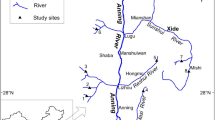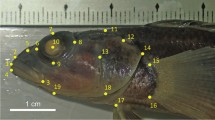Abstract
Diet selection of the Chilean stone crab Homolaspis plana (Milne-Edwards, 1834) was studied using the optimal foraging theory to explain its feeding strategy. The hypothesis that H. plana prefers prey species of the highest prey (“energy”) value was experimentally tested on adult crabs during 1980–1981. Food value was defined as the ratio between caloric content and consumption time, according to energy maximization as the criterion to optimize diet selection. Diet composition of adult crabs from the littoral of Valparaíso (Chile) and ingestion under laboratory conditions were studied to determine type, size and quantity of food to be offered in experiments on prey-type preference. Porcellanid crabs, barnacles and bivalves were the most frequently occurring items in stomachs from in situ conditions. In the aquaria, daily ingestion rates were quite variable among crabs and among days. H. plana showed no size preference for molluscs (Tegula atra, Semimytilus algosus) but preferred larger sizes of porcellanids. The order of preference for prey type was S. algosus>T. atra> porcellanids. However, no differences between their energy values were found and, therefore, the optimal foraging hypothesis was rejected. By extension, the energy maximization criterion alone may not explain the diet selection of H. plana under experimental conditions.
Similar content being viewed by others
Literature cited
Antezana, T., E. Fagetti y M. T. López: Observaciones bioecológicas en decápodos comunes de Valparaíso. Revta Biol. mar. 12, 1–60 (1965)
Blundon, J. A. and V. S. Kennedy: Mechanical and behavioral aspects of blue crab, Callinectes sapidus (Rathbun), predation on Chesapeake bay bivalves. J. exp. mar. Biol. Ecol. 65, 47–65 (1982)
Cock, M. J.: The assessment of preference. J. Anim. Ecol. 47, 805–816 (1978)
Conover, W. J.: Practical nonparametric statistics, 462 pp. New York: John Wiley & Sons 1971
Chesson, J.: Measuring preference in selective predation. Ecology 59, 211–215 (1978)
Elner, R. W. and R. Hughes: Energy maximization in the diet of the shore crab Carcinus maenas. J. Anim. Ecol. 47, 103–116 (1978)
Goss-Custard, J. D.: The energetics of prey selection by redshank Tringa totanus (L.), in relation to prey density. J. Anim. Ecol. 46, 1–19 (1977)
Hughes, R. N.: Optimal foraging theory in the marine context. Oceanogr. mar. Biol. A. Rev. 18, 423–481 (1980)
Hughes, R. N. and R. W. Elner: Tactics of a predator Carcinus maenas, and morphological responses of the prey, Nucella lapillus. J. Anim. Ecol. 48, 65–78 (1979)
Hughes, R. N. and R. Seed: Size selection of mussels by the blue crab Callinectes sapidus: energy maximizer or time minimizer? Mar. Ecol. Prog. Ser. 6, 83–89 (1981)
Johnson, D. H.: The comparison of usage and availability measurements for evaluating resource preference. Ecology 61, 65–71 (1980)
Landenberger, D. E.: Studies on selective feeding in the Pacific starfish Pisaster in Southern California. Ecology 49, 1062–1075 (1968)
Morales, C.: Estrategia alimentaria en Homalaspis plana (Milne Edwards, 1834) (Crustacea: Decapoda: Xanthidae), 83 pp. Licenciate in Biology thesis, University of Valparaíso, Chile 1981
Paine, R.: Endothermy in bomb calorimetry. Limnol. Oceanogr. 11, 126–129 (1966)
Paloheimo, J. E.: Indices of food type preference by a predator. J. Fish. Res. Bd Can. 36, 470–473 (1979)
Pyke, G. H., H. R. Pulliam and E. L. Charnov: Optimal foraging: a selective review of theory and tests. Q. Rev. Biol. 52, 137–154 (1977)
Schoener, T. W.: Theory of feeding strategies. A. Rev. Ecol. Syst. 2, 369–404 (1971)
Sih, A.: Optimal diet: the relative importance of the parameters. Am. Nat. 112, 460–430 (1978)
Sokal, R. R. and F. J. Rohlf: Biometry. The principles and practice of statistics in biological research, 776 pp. San Francisco: W. H. Freeman & Co. 1969
Werner E. E. and D. J. Hall: Optimal foraging and the size selection of prey by the bluegill sunfish (Lepomis macrochirus). Ecology 55, 1042–1052 (1974)
Author information
Authors and Affiliations
Additional information
Communicated by J. Mauchline, Oban
Rights and permissions
About this article
Cite this article
Morales, C., Antezana, T. Diet selection of the Chilean stone crab Homalaspis plana . Mar. Biol. 77, 79–83 (1983). https://doi.org/10.1007/BF00393212
Accepted:
Issue Date:
DOI: https://doi.org/10.1007/BF00393212




